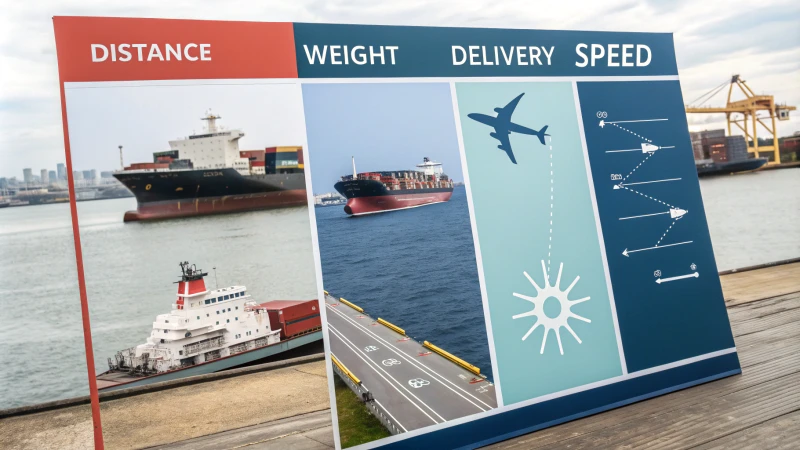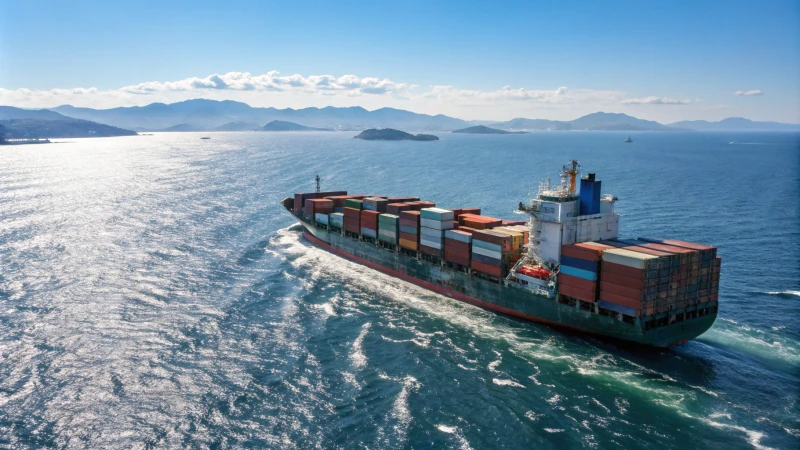Back when I started importing electronics from China, the shipping times felt like the biggest puzzle to solve.
Shipping from China to New Zealand can take anywhere from 3 to 35 days, depending on your chosen method. Sea freight usually takes 20-35 days, air freight 5-8 days, and express shipping 3-7 days. Each method varies in cost and speed, influencing logistics planning.
When I first ventured into importing, understanding these timeframes was crucial for my planning. Every method has its unique quirks—like when I first tried express shipping and learned the hard way about its cost versus speed trade-off. Let's dive deeper into these options and how they can align with your business strategy.
Express shipping takes 3-7 days from China to New Zealand.True
Express shipping is the fastest method, typically taking 3-7 days.
Sea freight is faster than air freight for shipping to New Zealand.False
Sea freight takes 20-35 days, while air freight takes 5-8 days.
What Are the Pros and Cons of Each Shipping Method?
Choosing the right shipping method is like picking the perfect outfit for an occasion—it all depends on the situation.
Picking the best shipping method involves weighing speed, cost, and goods type. Air freight is speedy yet costly, sea freight is budget-friendly for bulk, and express caters to urgent deliveries.

Air Freight: Speed vs. Cost
When I think of air freight, it's like booking a first-class ticket for my goods. It's fast, which is great when I'm in a pinch, but wow, does it come with a price tag! Imagine needing those consumer electronics to meet a sudden demand spike—air freight gets them there pronto. However, for those bigger shipments, I often pause at the cost. It's really ideal when time and value are critical.
- Pros: Fast delivery (5-8 days), reliable schedules.
- Cons: Expensive, limited cargo size.
Sea Freight: Economy for Bulk
Sea freight always reminds me of a slow yet steady journey—like taking the scenic route to your destination. Perfect for those large batches of products that aren't in a rush. I remember the first time I used sea freight; the cost savings were huge, but I had to plan ahead to account for the longer transit time. It's a great option for non-urgent shipments where every penny counts.
- Pros: Cost-effective for large quantities.
- Cons: Longer transit times, potential delays.
Express Shipping: Quick and Convenient
Express shipping feels like having a superhero swoop in to save the day. It's my go-to when there's an unexpected demand or a last-minute request from a client. While it's pricier than regular shipping, the speed and convenience often make up for it. I still remember how it saved one of my biggest deals by getting those crucial components delivered just in time.
- Pros: Fast, door-to-door service.
- Cons: Higher costs compared to regular shipping.
Choosing Based on Needs
Deciding on a shipping method is like piecing together a puzzle—each decision fits based on your current needs. I weigh up factors like the nature of the goods, budget constraints, and how quickly things need to get moving. Here's a quick summary that helps me decide:
| Method | Speed | Cost | Best For |
|---|---|---|---|
| Air Freight | 5-8 days | High | Urgent or high-value goods1 |
| Sea Freight | 20-35 days | Low | Large, non-urgent shipments2 |
| Express | 3-7 days | Moderate to High | Small, urgent parcels3 |
By considering these factors, I can make strategic choices that keep my business running smoothly and my clients happy. This careful analysis helps me ensure that every shipment aligns perfectly with my logistics goals4.
Air freight is the most cost-effective method.False
Air freight is fast but expensive, not cost-effective for bulk.
Sea freight is ideal for perishable goods.False
Sea freight takes 20-35 days, unsuitable for perishables.
How Does Seasonality Affect Shipping Times?
Ever notice how shipping times seem to have a mind of their own, especially around the holidays? Let's dive into how seasonality might be playing tricks on your logistics.
Seasonality affects shipping times by changing demand levels, weather conditions, and holiday schedules, leading to longer transit times and higher costs. To navigate these fluctuations, understanding the impact of each season is essential for effective logistics planning.

Peak Seasons and Demand Fluctuations
Ah, the holiday season—a time of joy, gifts, and...shipping delays. I've learned this the hard way when my living room became a temporary warehouse as I waited for shipments to clear congested ports during Christmas. The frenzy of Black Friday and festive shopping can turn ports into a bustling hub, with freight forwarders racing against time to manage the surge in demand.
Weather Conditions
Picture this: you're all set for a smooth delivery, and then a snowstorm decides to crash the party. Winter conditions can throw a wrench into sea freight routes, while summer hurricanes make air freight operations a game of dodgeball. I've had my fair share of rescheduling due to Mother Nature's antics, reminding me that having contingency plans is more than just wise—it's essential.
| Weather Impact | Season | Potential Delays |
|---|---|---|
| Hurricanes | Summer | Port closures |
| Snowstorms | Winter | Road blockages |
| Typhoons | Autumn | Flight cancellations |
Holiday Schedules and Cultural Events
Then there are those global holidays that catch you off guard. I recall a time when Chinese Lunar New Year turned my shipping timeline upside down. For weeks, production lines and shipping ground to a halt, affecting my wholesale business5's rhythm. Understanding these cultural events has become part of my logistics homework.
Strategies for Mitigating Seasonal Effects
- Forecast Demand: I've started using historical data like a weather forecast—predicting demand spikes helps me stay one step ahead.
- Flexible Logistics Partners: Finding freight forwarders who can dance through these seasonal challenges has been a lifesaver.
- Diversify Routes: I've learned to always have a plan B or C—exploring alternative routes or transport modes can be a game-changer.
By embracing these strategies, I've managed to soften the blow of seasonal disruptions on my supply chain. And if you're curious about more ways to plan strategically during peak seasons, don't miss our guide6 on optimizing logistics for seasonal fluctuations.
Peak seasons cause shipping delays.True
Increased demand during peak seasons leads to congested ports and delays.
Snowstorms mainly affect summer shipping.False
Snowstorms occur in winter, causing road blockages and delays.
How Do Different Shipping Options Affect Costs?
Ever been caught between choosing speed or saving on shipping costs? I have, and it's a real dilemma.
Shipping costs fluctuate based on method, distance, speed, weight, and size. Sea freight is budget-friendly for bulk shipments, while air freight trades cost for speed.

Understanding Shipping Costs by Method
Navigating the maze of shipping options can feel overwhelming, but here's how I break it down to keep things simple. Different shipping methods come with unique cost implications. Here's a brief comparison to help you evaluate shipping choices7.
| Method | Speed | Cost Implication |
|---|---|---|
| Sea Freight | 20-35 days | Lowest for large volumes |
| Air Freight | 5-8 days | Higher, speed premium |
| Express | 3-7 days | Highest, fastest option |
Factors Influencing Shipping Costs
- Distance: I remember my first international shipment; the costs added up quickly with fuel surcharges and fees. It's something to keep in mind if you're shipping far.
- Weight & Volume: Once, I shipped a bulky order and was surprised by the cost. Carriers often use dimensional weight for pricing bulky items.
- Speed: If you're like me and value time, express options are tempting, but they come with a price.
Cost-Saving Strategies
I've learned a few tricks over the years to keep shipping costs in check:
- Consolidation: When I combine shipments, it reduces costs per unit—a little planning goes a long way.
- Freight Forwarders: Partnering with experts like Gofreighter8 can lead to bulk discounts and tailored solutions.
- Timing: Planning around peak seasons has saved me from surcharges. It’s worth considering if you’re not in a rush.
Analyzing Air vs. Sea Freight
For businesses importing from regions like Asia, choosing between air and sea freight can be pivotal. I've faced this choice many times.
- Sea Freight: Ideal for large, non-urgent consignments. Economical but slow, suitable for heavy goods.
- Air Freight: Best for high-value, time-sensitive items. Offers quick delivery but at a higher cost.
Understanding these factors can guide businesses in making cost-effective decisions, ensuring they maintain competitiveness without sacrificing service quality.
For more detailed insights on shipping cost calculators9, explore tools that offer estimates based on your specific needs.
Sea freight is the cheapest for large shipments.True
Sea freight offers the lowest cost for transporting large volumes over long distances.
Express shipping is cheaper than air freight.False
Express shipping is the most expensive option due to its fast delivery times.
Conclusion
Shipping from China to New Zealand varies by method: sea freight takes 20-35 days, air freight 5-8 days, and express shipping 3-7 days, influencing cost and logistics planning.
-
Explore the benefits of air freight to understand its value in urgent and high-value shipments. ↩
-
This link helps you compare sea and air freight, offering insights into cost-efficiency and speed. ↩
-
Learn about express shipping's speed and convenience to optimize urgent parcel deliveries. ↩
-
Discover tips on selecting the most suitable shipping method based on your specific needs. ↩
-
Learn about the impact of the Lunar New Year on Chinese manufacturing and shipping operations. ↩
-
Discover effective strategies to enhance logistics performance during high-demand periods. ↩
-
This link will provide guidance on selecting the most suitable shipping method based on your specific business needs. ↩
-
Explore how using a freight forwarder can streamline your shipping process and potentially reduce costs. ↩
-
Discover tools that can help you estimate shipping costs accurately based on your shipment parameters. ↩




